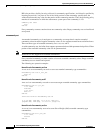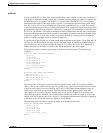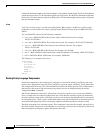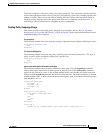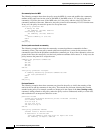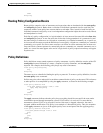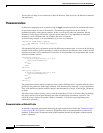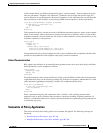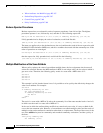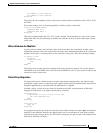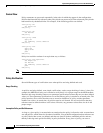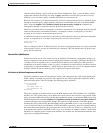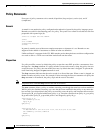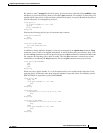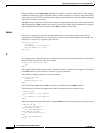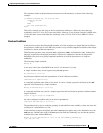
Implementing Routing Policy on Cisco IOS XR Software
Information About Implementing Routing Policy on Cisco IOS XR Software
RC-366
Cisco IOS XR Routing Configuration Guide
OL-14356-01
• When Attributes Are Modified, page RC-367
• Default Drop Disposition, page RC-367
• Control Flow, page RC-368
• Policy Verification, page RC-368
Boolean Operator Precedence
Boolean expressions are evaluated in order of operator precedence, from left to right. The highest
precedence operator is not, followed by and, and then or. The following expression:
med eq 10 and not destination in (10.1.3.0/24) or community matches-any ([10..25]:35)
if fully parenthesized to display the order of evaluation, would look like this:
(med eq 10 and (not destination in (10.1.3.0/24))) or community matches-any ([10..25]:35)
The inner not applies only to the destination test; the and combines the result of the not expression with
the Multi Exit Discriminator (MED) test; and the or combines that result with the community test. If the
order of operations are rearranged:
not med eq 10 and destination in (10.1.3.0/24) or community matches-any ([10..25]:35)
then the expression, fully parenthesized, would look like the following:
((not med eq 10) and destination in (10.1.3.0/24)) or community matches-any ([10..25]:35)
Multiple Modifications of the Same Attribute
When a policy replaces the value of an attribute multiple times, the last assignment wins because all
actions are executed. Because the MED attribute in BGP is one unique value, the last value to which it
gets set to wins. Therefore, the following policy results in a route with a MED value of 12:
set med 9
set med 10
set med 11
set med 12
This example is trivial, but the feature is not. It is possible to write a policy that effectively changes the
value for an attribute. For example:
set med 8
if community matches-any cs1 then
set local-preference 122
if community matches-any cs2 then
set med 12
endif
endif
The result is a route with a MED of 8, unless the community list of the route matches both cs1 and cs2,
in which case the result is a route with a MED of 12.
In the case in which the attribute being modified can contain only one value, it is easy to think of this
case as the last statement wins. However, a few attributes can contain multiple values and the result of
multiple actions on the attribute is cumulative rather than as a replacement. The first of these cases is the
use of the additive keyword on community and extended community evaluation. Consider a policy of
the form:
route-policy community-add
set community (10:23)



